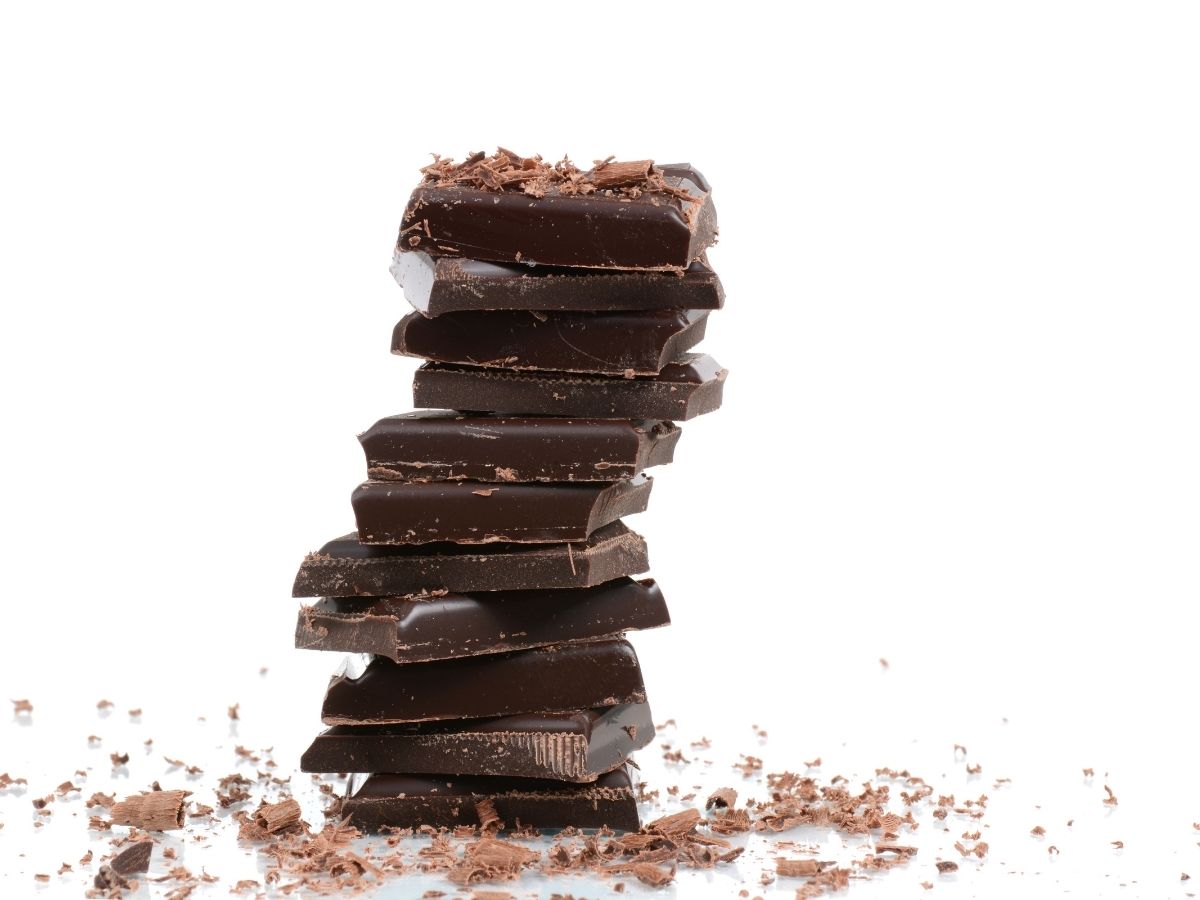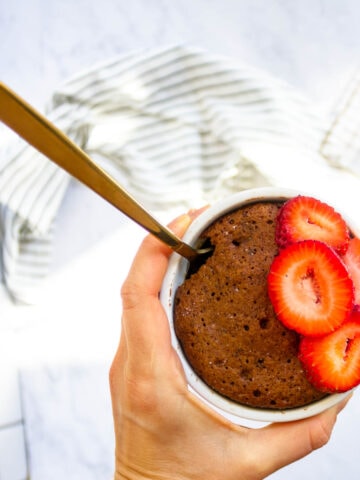
You ran out in the middle of the recipe. You simply hate the flavour. You're allergic. Whatever the reason is that you're looking for an alternative, I have healthy substitutes for cocoa powder for you.
Jump to:
Cocoa powder is the magic ingredient that gives chocolate dishes their delicious flavour and rich colour. It's used in everything from smoothies, to brownies, to puddings, to granola, to cakes. And, don't kid yourself, these chocolate desserts and recipes wouldn't be as good without it.
Cocoa powder has a strong chocolate taste. But, unlike a bar of chocolate, that's creamy and sweet, cocoa powder has more of a bitter, astringent taste. The addition of cocoa powder to your recipe will add a rich, light brown hue.
When looking for a cocoa powder substitute, you want to find an option that matches in flavour and texture. From dutch process cocoa to dark chocolate, there are several ingredients you can swap in that you probably already have in your kitchen.
Scroll down to see the full list of options.
Top picks
If you're in a rush, I get it. Below are my two favourite cocoa powder replacements that you can find at your local grocery store.
Want to know more? Keep scrolling for all the details on how to use these two options and so much more.
 Buy Now →
Buy Now →  Buy Now →
Buy Now → 1. Dutch process cocoa

Dutch process cocoa powder can be used in place of cocoa powder in a 1:1 ratio.
Pros:
- Dutch-process is a variety of cocoa powder. To make it, cocoa powder is washed with a potassium carbonate solution that neutralizes the acidity of the cocoa powder, making it smoother and more mellow than the original.
Cons:
- Cocoa powder is slightly more acidic than dutch process cocoa. The acid reacts with baking soda, so is important when baking soda is the leavener in your recipe.
- Dutch-process powder has a darker brown hue, which can change the colour of your final dish.
Special notes:
- If your recipe uses baking soda, don't worry. You can mimic the acidity of cocoa powder by adding ⅛ teaspoon of acid (like lemon juice, cream of tartar or white vinegar) to every 3 tablespoons of dutch-process cocoa powder.
- If the recipe uses baking powder, then dutch-process cocoa is actually the better alternative.
- If the recipes uses both baking powder and baking soda, then either cocoa powder or dutch-process powder will work.
- To purchase dutch processed cocoa powder look for the following on the label: European style, dutched, cocoa processed with alkali, or alkalized.
Caitey Jay's top pick:
 Buy Now →
Buy Now → 2. Cacao powder

Cacao powder can be used in place of cocoa powder in a 1:1 ratio. Although, you may want to use slightly less due to it's stronger taste.
Pros:
- Cacao powder is another variety of cocoa powder. It's less processed and higher in antioxidants, which is great from a health perspective.
- Because it's also derived from the cocoa bean, the flavour is quite similar, with a more intense chocolate flavour.
- It looks a lot like cocoa powder and will provide similar coloring to your recipe.
Cons:
- Because it's less processed, it retains more of the natural flavour of the cocoa bean, making it stronger and more bitter than cocoa powder. You may want to balance this by reducing the quantity or adding more sweetener to your recipe.
Caitey Jay's top pick:
 Buy Now →
Buy Now → 3. Unsweetened baking chocolate

Unsweetened baking chocolate can be used in place of cocoa powder. For every 3 tablespoons of cocoa powder, replace with 1 ounce of unsweetened baking chocolate.
Pros:
- Like cocoa powder, unsweetened baking chocolate is made from cocoa beans. Because of this, they have a similar flavour profile.
- It looks a lot like cocoa powder and will provide similar coloring to your recipe.
Cons:
- Baking chocolate is less chocolate-y than cocoa powder because it has less cocoa solids. That means your recipe won't have quite the same decadent chocolate flavour.
- Unlike cocoa powder, baking chocolate contains cocoa butter, which makes it a solid. That means it requires a little effort to swap. First, you'll have to melt the chocolate. Second, because it contains cocoa butter, you'll have to remove fat from your recipe when substituting.
Special notes:
- Add the melted chocolate to the recipe at the same time as butter (or other fat) to ensure it gets well integrated into your recipe.
- Remove two tablespoons of fat (like butter or shortening) from your recipe for every 2 ounces of baking chocolate used.
Caitey Jay's top pick:
 Buy Now →
Buy Now → 4. Carob powder

Carob powder can be used in place of cocoa powder in a 1:1 ratio.
Pros:
- Carob is the best-known substitute for chocolate.
- It looks a lot like cocoa powder and will provide similar coloring to your recipe.
- It's a simple swap, as you'll use exactly the same amount of carob powder as cocoa powder.
Cons:
- The flavour is not identical to chocolate, as it lacks the bitter and astringent taste that cocoa powder is known for.
Caitey Jay's top pick:
 Buy Now →
Buy Now → 5. Dark chocolate

Dark chocolate can be used as a substitute for cocoa powder in a 1:1 ratio.
Pros:
- Dark chocolate is derived from the cocoa bean, so will have a rich chocolate flavour. Because it's low in added sugar, it has a bitter flavour that's fairly similar to cocoa powder.
- Dark chocolate is very nutritious and full of powerful antioxidants.
Cons:
- It's more complicated to swap. You need to melt the chocolate before adding it to your recipe so it can bond to the rest of your ingredients.
Special notes:
- Add the melted chocolate to your recipe at the same time as the fat (such as butter or shortening). This ensures it gets well integrated.
Caitey Jay's top pick:
 Buy Now →
Buy Now → 6. Chocolate chips

Chocolate chips can be used as an alternative to cocoa powder. For every 3 tablespoons of cocoa powder, use 3 tablespoons of melted dark chocolate.
Pros:
- Chocolate chips are derived from the cocoa bean, so will have a rich chocolate flavour.
Cons:
- They're more complicated to swap. You need to melt the chocolate chips before adding them to recipe so they can bond to the rest of your ingredients.
- They are sweeter than cocoa powder because they also contain sugar and cocoa butter. You may need to reduce the amount of sweetener in your recipe.
Special notes:
- Dark chocolate chips will more closely replicate the flavour of cocoa powder because they contain less sweetener. If you have these on hand, use these.
- Add the melted chocolate to the recipe at the same time as butter (or other fat) to ensure it gets well integrated into your recipe.
Caitey Jay's top pick:
7. Hot cocoa mix

Hot cocoa mix can be used a cocoa powder substitute in a 2:1 ratio.
Pros:
- Hot cocoa mix is made with a small amount of cocoa powder, sweetener, milk solids and spices. While it doesn't perfectly replicate the flavour of cocoa powder, it can work in some recipes.
Cons:
- The extra ingredients and spices in hot cocoa mix will likely have unintended consequences on your recipe.
- Cocoa powder has less sugar, which is better for your health.
Special notes:
- Hot cocoa mix is different than hot chocolate mix. Hot chocolate mix has a fuller chocolate flavor and thicker texture than hot cocoa mix because it also includes creamer. That said, it can also be used as a substitute for cocoa powder in a 2:1 ratio. But, you'll likely need to reduce the sweetener in your recipe to accommodate the richer flavour.
Caitey Jay's top pick:
 Buy Now →
Buy Now → Summary
There are a number of reasons you might be looking for a cocoa powder alternative. From food intolerances to lack of availability to taste presences.
These are the best cocoa powder substitutes:
- To imitate the color of cocoa powder most closely, use cacao powder.
- To mimic the taste of cocoa powder most closely, use dutch process cocoa powder or cacao powder.
- If you don't have any of these varieties of cocoa powder on hand, use carob powder, unsweetened baking chocolate, dark chocolate or chocolate chips.
- As a last resort, use hot cocoa or hot chocolate mix.
What is cocoa powder?
- Cocoa powder (also known as natural cocoa powder) is made from cocoa beans, which are the seed of the cocoa tree. These seeds are dried and fermented, then cocoa solids and butter are extracted from them. Cocoa solids are ground into cocoa powder.
- It has a bitter and astringent flavour due it to it's highly acidic pH.
- Dutch-process cocoa powder is alkalized, which lowers the pH and creates a more mellow flavour.
- In addition to flavour, cocoa powder is often used for color in recipes, giving its dishes a light brown hue.
- When purchasing cocoa powder, look for unsweetened. This means sugar hasn't been added to the final product.
- Cocoa powder should be stored in an airtight container in a cool, dry place, like a pantry or cupboard. It will last up to two years, but flavour will fade slightly over time time. Do not store in the fridge or freezer.

How to use cocoa powder
I’ll share some of my favourite recipes using natural cocoa powder below. But, to make you the master of your own kitchen, I want to share a few ideas on how you can start using cocoa powder.
- In smoothies. Cocoa powder has an intense chocolate-y flavour that will make you forget your drinking a green smoothie. Plus, it adds an anti-inflammatory boost to your drink. Check out my go-to chocolate green smoothie.
- In baking. From cake to brownies to puddings to granola. Cocoa powder is the star of every decadent chocolate dish.
Is cocoa powder healthy?
Inflammation in response to injury or infection is a natural and helpful response within our body. It actually heals us.
But, inflammation can also happen in response to poor diet, lack of exercise, excessive stress and a deficiency in sleep. In these cases, our immune system is triggered to go into action, but it doesn't really have anything to fight.
This kind of inflammation in the body can contribute to a number of health issues like digestive issues, headaches and migraines, fatigue, brain fog and skin rashes. Over the long term, this inflammation can have even more damaging consequences, even damaging our arteries, organs and joints.
The good news is that your diet, sleep hygiene and workout routine matter a lot when it comes to reducing inflammation.
In regards to diet, a good place to start is to increase your frequency of foods that fight inflammation.
Cocoa powder is one of these foods. That's because it's one of the richest sources of polyphenols, which are naturally occuring antioxidants that can help reduce inflammation.
Cocoa powder has also been linked to improved heart and brain health, lowered cholesterol, blood sugar and weight management, and healthy teeth and skin.
Have you tried any of these subs for cocoa powder? Do you have any of your own? Please take a minute to leave a comment below with your suggestions.






Leave a comment!